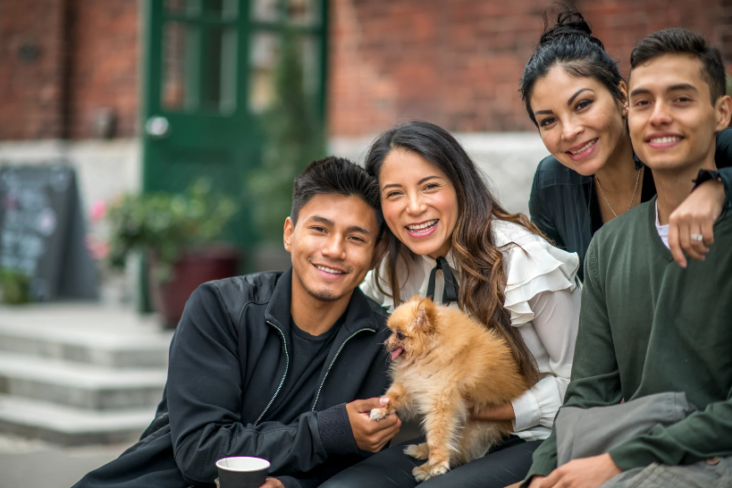Liz Aviles and Gerardo “G” Orta are both proud descendants of Latine immigrants and torchbearers for their parents’ American dreams.
They’re also both marketing experts at Advantage Solutions who see an immense and growing opportunity for brands to better market to Latine consumers. Latinos are the largest and fastest-growing minority population in the U.S., with an estimated GDP of nearly $3.7 trillion, according to the 2024 U.S. Latino GDP Report, which measures the economic contribution of Hispanic men and women in the U.S.
They also represent a powerful consumer base that continues to grow younger, more diverse and more influential. Citing data from a YPulse Hispanic Youth Special report, Aviles said the vast majority of young Latine people are born in the U.S. and proud of their cultural identity.
“This shift is leading to a population of young Latinos who are more integrated into American culture than ever before, even as they maintain their Latine cultural identity,” said Aviles, who is senior vice president of strategy and cultural insights at Amp, a marketing agency at Advantage Solutions
Reaching these consumers requires going beyond tired tropes and stereotypes, and instead engaging them in a way that conveys authentic cultural understanding.
Avoiding harmful stereotypes
Brand marketers must start with curiosity and empathy for Latine cultures, said Orta, vice president of strategic planning and shopper insights at Advantage Unified Commerce, which provides omnicommerce solutions and data analytics for brands and retailers.
Too often, brands rely on stereotypes and rudimentary Spanish/Spanglish phrases that end up feeling inauthentic or even insulting, said Orta, who is Mexican-American.

“The way we are engaged or brought to screen or brought to life in an ad or and talked to can be very positive and very real — or very dangerously filled with assumptions, stereotypes or good intentions that translate in negatively impactful ways within the community,” Orta said.
The superficial marketing grows rampant for popular occasions like Cinco De Mayo (which many Mexican people don’t even celebrate), Hispanic Heritage Month, which runs from Sept. 15 to Oct. 15, and Dia De Los Muertos, he said.
“As marketers, those are going to be our big tentpole events,” Orta said. “But how do we embrace and celebrate the occasions in the right way, versus leaning into stereotypes of cultural appropriation?”
In the U.S., Latine consumer demand is growing across categories, including food and snacks, beverages, personal care, household products, technology and more, according to AUC data.
And Generation Z, which is considered to be the largest and wealthiest generation, is more than one-quarter Hispanic. The vast majority of those younger Latine consumers speak at least some English, Orta said.
“When we talk about Gen Zers, Spanish is not even your best vehicle,” Orta said, “which forces you to understand the lifestyle, the lived experience and the role of culture beyond language.”
Lived experience in the room
In her early childhood years, Aviles’ family lived paycheck to paycheck, and they were forced to make tough decisions at the grocery store.
Her father immigrated from Cuba in 1963, living first in Miami, before eventually moving to Kansas City, where he met her mother, a Mexican-American.
She’s brought that lived experience to her work at Advantage Solutions. At times, in conversations with clients, she’s the only Latine person in the room — even when discussing how to appeal directly to Latine consumers.

“It’s important to have not just the people in the room who are experts — because they’re working with good data sources, because they have good insights partners at their disposal — but also to have people on your team who have a diversity of lived experience,” Aviles said.
Having that lived experience in the room helps reach consumers more efficiently, and just as importantly, avoids costly errors.
For instance, Aviles helped but the brakes on a project to create a subscription service and a bundle package aimed at lower-income Latino shoppers. Calling upon her own lived experience, Aviles advised her client that these shoppers are buying only what they need for the week.
“If I hadn’t been in that room, then you have the potential for a program to move through a system unchecked by any sort of cultural insight, to create a program that is not going to work,” Aviles said.
The power of community
The opportunity is ripe for brands to further develop and refine their strategy for marketing to Latine consumers in a more meaningful way, Orta and Aviles say.
At Advantage, the teams at AUC and Amp provide powerful data analytics, cutting edge insights, and shopper-centric end-to-end marketing expertise to help brands better speak to Latino consumers. They also employ leaders like Aviles and Orta, who know Latino consumers because they are Latino consumers.
On the retailer services side, Advantage employs a team of about 30 Latine team members who directly support smaller local retailers serving predominately Hispanic communities across the U.S., said Andy Keenan, executive vice president of branded retail services.
“Our team provides services — in communities where they live — to retailers that remain largely underserved,” Keenan said. “Advantage sees this as an area for growth.”
In conversations with brand clients, Orta said he starts with some simple questions.
“What about Hispanic people? Do we have a plan, and how can we use them as an opportunity to grow versus just as an afterthought?” he said. “And then use the power of our insights, our superior access to data and our ability to understand shoppers and behavior to create insightful, relevant and authentic programs and executions.”
And the focus on empathy through marketing transcends any particular demographic or identity, resonating with all consumers, Aviles said.
“One of the superpowers that you have when you belong to a community, it makes you more sensitive to ensuring that brands are talking to our community, or, let’s say, Black consumers, or LGBTQ+ consumers or Asian consumers in a way that’s authentic and real,” Aviles said.
Aviles and Orta hope to move the conversation forward.
Or as they put it: ¡Pa’lante!




